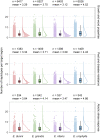Haplotype mining panel for genetic dissection and breeding in Eucalyptus
- PMID: 36394447
- PMCID: PMC10107644
- DOI: 10.1111/tpj.16026
Haplotype mining panel for genetic dissection and breeding in Eucalyptus
Abstract
To improve our understanding of genetic mechanisms underlying complex traits in plants, a comprehensive analysis of gene variants is required. Eucalyptus is an important forest plantation genus that is highly outbred. Trait dissection and molecular breeding in eucalypts currently relies on biallelic single-nucleotide polymorphism (SNP) markers. These markers fail to capture the large amount of haplotype diversity in these species, and thus multi-allelic markers are required. We aimed to develop a gene-based haplotype mining panel for Eucalyptus species. We generated 17 999 oligonucleotide probe sets for targeted sequencing of selected regions of 6293 genes implicated in growth and wood properties, pest and disease resistance, and abiotic stress responses. We identified and phased 195 834 SNPs using a read-based phasing approach to reveal SNP-based haplotypes. A total of 8915 target regions (at 4637 gene loci) passed tests for Mendelian inheritance. We evaluated the haplotype panel in four Eucalyptus species (E. grandis, E. urophylla, E. dunnii and E. nitens) to determine its ability to capture diversity across eucalypt species. This revealed an average of 3.13-4.52 haplotypes per target region in each species, and 33.36% of the identified haplotypes were shared by at least two species. This haplotype mining panel will enable the analysis of haplotype diversity within and between species, and provide multi-allelic markers that can be used for genome-wide association studies and gene-based breeding approaches.
Keywords: Eucalyptus; gene-centric genotyping; haplotype; multi-allelic markers.
© 2022 The Authors. The Plant Journal published by Society for Experimental Biology and John Wiley & Sons Ltd.
Conflict of interest statement
LGN was an employee of Rapid Genomics LLC during the execution of this project, and held ownership stocks at Rapid Genomics LLC during the execution of this project. Flex‐Seq Ex‐L is covered by patents belonging to Rapid Genomics LLC. The other authors declare no conflict of interest.
Figures


Similar articles
-
Targeted re-sequencing and genome-wide association analysis for wood property traits in breeding population of Eucalyptus tereticornis × E. grandis.Genomics. 2021 Nov;113(6):4276-4292. doi: 10.1016/j.ygeno.2021.11.013. Epub 2021 Nov 14. Genomics. 2021. PMID: 34785351
-
Quantitative genetic parameters for growth and wood properties in Eucalyptus "urograndis" hybrid using near-infrared phenotyping and genome-wide SNP-based relationships.PLoS One. 2019 Jun 24;14(6):e0218747. doi: 10.1371/journal.pone.0218747. eCollection 2019. PLoS One. 2019. PMID: 31233563 Free PMC article.
-
High-throughput SNP genotyping in the highly heterozygous genome of Eucalyptus: assay success, polymorphism and transferability across species.BMC Plant Biol. 2011 Apr 14;11:65. doi: 10.1186/1471-2229-11-65. BMC Plant Biol. 2011. PMID: 21492434 Free PMC article.
-
Eucalyptus applied genomics: from gene sequences to breeding tools.New Phytol. 2008;179(4):911-929. doi: 10.1111/j.1469-8137.2008.02503.x. Epub 2008 Jun 5. New Phytol. 2008. PMID: 18537893 Review.
-
Integrating genomics into Eucalyptus breeding.Genet Mol Res. 2004 Sep 30;3(3):369-79. Genet Mol Res. 2004. PMID: 15614728 Review.
Cited by
-
Comparison of ddRADseq and EUChip60K SNP genotyping systems for population genetics and genomic selection in Eucalyptus dunnii (Maiden).Front Genet. 2024 Mar 26;15:1361418. doi: 10.3389/fgene.2024.1361418. eCollection 2024. Front Genet. 2024. PMID: 38606359 Free PMC article.
-
A haplotype-resolved reference genome for Eucalyptus grandis.G3 (Bethesda). 2025 Jul 9;15(7):jkaf112. doi: 10.1093/g3journal/jkaf112. G3 (Bethesda). 2025. PMID: 40444387 Free PMC article.
References
Publication types
MeSH terms
LinkOut - more resources
Full Text Sources

